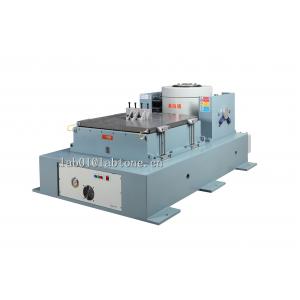

Add to Cart
Vibration Testing Equipment Simulate Real Life Environmental with
Random Vibration
Vibration Shaker
This test system generates vibration according to the parameters
such as arbitrary force, acceleration, and frequency. It can
evaluate various industrial products by applying vibration load.
Vibration test system for evaluating industrial products against
vibrations. The system consists of a vibration generator, a power
amplifier, and a vibration control system. It can provide a
vibration test to cope with various loads such as sine vibration,
random vibration, mechanical shock pulse and replication of
real-time trace.
Standard Models: EV203-EV220
| Model | EV203 | EV206 | EV210 | EV220 |
| Vibration Generator | VG300/40 | VG300/50 | VG1000/50 | VG2000/50 |
| Frequency(Hz) | 2-2500 | 2-3000 | 2-3000 | 2-2500 |
| Max Exiting Force(kg.f) | 300 | 600 | 1000 | 2000 |
| Max. Displacement (mmp-p) | 38 | 50 | 50 | 50 |
| Max. Acceleration(g) | 100 | 100 | 100 | 100 |
| Max. Velocity(cm/s) | 120 | 200 | 200 | 200 |
| Payload(kg) | 120 | 200 | 300 | 400 |
| Armature Mass(kg) | 3 | 6 | 10 | 20 |
| Armature Diameter(mm) | φ150 | φ200 | φ240 | φ320 |
| Cooling Method | Forced Air Cooling | |||
| Vibration Generator Weight(kg) | 460 | 920 | 1100 | 1600 |
| Vibration Generator Dimension L*W*H(MM) | 750*555*670 | 800*600*710 | 845*685*840 | 1200*870*1100 |
| Power Amplifier | Amp3k | Amp6k | Amp12k | Amp22k |
| Cooling Method | Forced Air Cooling | |||
| Power Amplifier Weight(kg) | 250 | 320 | 350 | 500 |
| Power Amplifier Dimension L*W*H(MM) | 800*550*1250 | 800*550*1250 | 800*550*1520 | 800*550*1520 |
| Utility Requirements | 3-phase AC380V ±10% 50Hz | |||
| Aggregate Capacity(KW) | 9 | 20 | 25 | 35 |
Features:
How to select a Vibration Test System:
Finding a proper system to run a particular test on a particular
specimen involves three distinct steps:
Applicable Standards:
MIL-STD, DIN, ISO, ASTM, IEC, ISTA, GB, GJB, JIS, BS etc.
Applicable Industries:
Automotive, Electronics, Aerospace, Vessel, Telecommunication,
Pptoelectronics, Instrument etc.
Working Principle:
